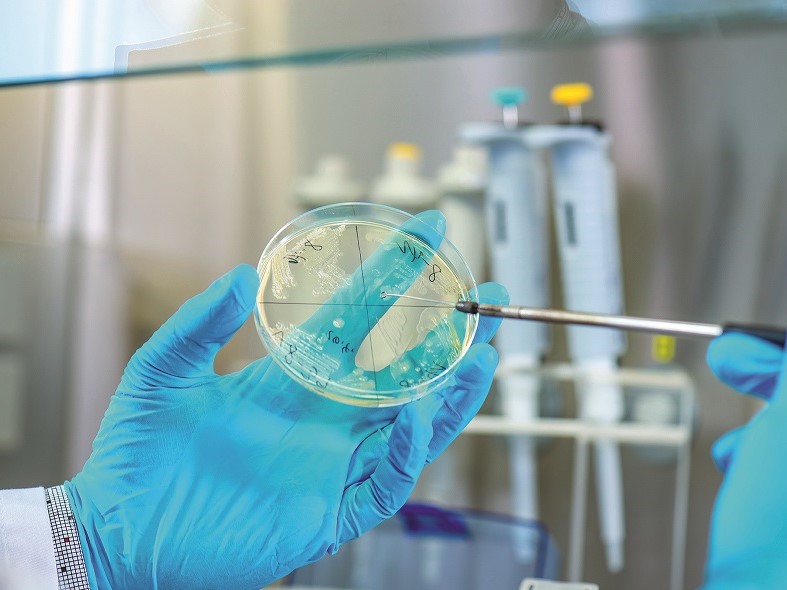Leibniz Centre for Agricultural Landscape Research (ZALF) - Planting for the future

In 2020, the Year of Science focuses on bioeconomy. Therefore, it is fitting that Brandenburg is the land of bioeconomy. In addition, the Leibniz Centre for Agricultural Landscape Research (ZALF) in Müncheberg (Märkisch-Oderland) is working to ensure that people will be able to farm, cultivate and live more sustainably on an organic basis in the future.
Highly concentrated, the man in the white coat looks at the transparent microscope slide. Living creatures invisible to the naked eye are scurrying across the slide: microbiomes. Microscopically small organisms that colonise a plant. They are only a thousandths of a millimetre in size – and thus for example about a thousand times smaller than a louse. Usual representatives of these microbial communities are bacteria and mushrooms. There are several thousand species per plant. At the Leibniz Centre for Agricultural Landscape Research they are bred – and researched.
Understanding the climate, improving agriculture
For this purpose, scientists record and analyse the DNA that is the genetic material of all microorganisms on a crop plant and in soils. This provides information on how microorganisms and plants interact and influence each other, for example in terms of growth, climate, site conditions, diseases and soil fertility. “This knowledge is necessary to prepare landscapes for climate change and to reduce resources such as fertilizers and pesticides,” explains Professor Steffen Kolb, co-head of the research area “landscape functioning” at ZALF. Colleague Hendrik Schneider adds: “Microorganisms are also interesting and important, because they “digest” organic soil material and “exhale” greenhouse gas emissions like methane.”
Guarantee for excellent research
At ZALF, experts from several disciplines are conducting research on how microorganisms affect plant growth and climate changes. Since March 2020, around 375 scientists have been able to work even more intensively across disciplines – all under one roof. In a new building complex, the “House of Cultural Biome Research”. It houses ten modern laboratories, eight new offices, a storage room for insects, a climatic chamber for plants and a workshop where, among other things, equipment for field trials is developed. The State of Brandenburg, the federal government and the EU invested around four million euros in the construction. 80 percent of the costs was funded by the European Regional Development Fund (ERDF). “The working environment is optimal,” reports Kolb. “Moreover, the funding also makes the location attractive for excellent scientific research employees.” Additionally, the new building expands the competencies and research skills in cultural biome research in Brandenburg and also strengthens the international agricultural research.
For further information, visit www.zalf.de
Highly concentrated, the man in the white coat looks at the transparent microscope slide. Living creatures invisible to the naked eye are scurrying across the slide: microbiomes. Microscopically small organisms that colonise a plant. They are only a thousandths of a millimetre in size – and thus for example about a thousand times smaller than a louse. Usual representatives of these microbial communities are bacteria and mushrooms. There are several thousand species per plant. At the Leibniz Centre for Agricultural Landscape Research they are bred – and researched.
Understanding the climate, improving agriculture
For this purpose, scientists record and analyse the DNA that is the genetic material of all microorganisms on a crop plant and in soils. This provides information on how microorganisms and plants interact and influence each other, for example in terms of growth, climate, site conditions, diseases and soil fertility. “This knowledge is necessary to prepare landscapes for climate change and to reduce resources such as fertilizers and pesticides,” explains Professor Steffen Kolb, co-head of the research area “landscape functioning” at ZALF. Colleague Hendrik Schneider adds: “Microorganisms are also interesting and important, because they “digest” organic soil material and “exhale” greenhouse gas emissions like methane.”
Guarantee for excellent research
At ZALF, experts from several disciplines are conducting research on how microorganisms affect plant growth and climate changes. Since March 2020, around 375 scientists have been able to work even more intensively across disciplines – all under one roof. In a new building complex, the “House of Cultural Biome Research”. It houses ten modern laboratories, eight new offices, a storage room for insects, a climatic chamber for plants and a workshop where, among other things, equipment for field trials is developed. The State of Brandenburg, the federal government and the EU invested around four million euros in the construction. 80 percent of the costs was funded by the European Regional Development Fund (ERDF). “The working environment is optimal,” reports Kolb. “Moreover, the funding also makes the location attractive for excellent scientific research employees.” Additionally, the new building expands the competencies and research skills in cultural biome research in Brandenburg and also strengthens the international agricultural research.
For further information, visit www.zalf.de

